Adsorption Kinetics of Methyl Orange from Model Polluted Water onto N-Doped Activated Carbons Prepared from N-Containing Polymers
Abstract
1. Introduction
2. Materials and Methods
2.1. Materials
2.2. Preparation of Adsorbents
2.3. Assessment of Surface Charge
2.4. Adsorbate Solution
2.5. Adsorption Kinetic Experiments
2.6. Characterization
2.7. Adsorption Kinetic Models
2.7.1. Pseudo-First-Order Kinetic Model (PFO)
2.7.2. Pseudo-Second-Order Kinetic Model (PSO)
2.7.3. Elovich Kinetic Model
2.7.4. Intra-Particle Diffusion Kinetic Model (IPD)
2.7.5. Liquid Film Diffusion Kinetic Model (LFD)
3. Results and Discussion
3.1. Adsorbents Properties
3.1.1. Physicochemical Properties
3.1.2. Surface Morphology
3.1.3. FTIR Spectra
3.1.4. Thermal Analysis
3.2. Adsorption Studies
3.2.1. Effect of Solution pH
3.2.2. Effect of Adsorbate Initial Concentration
3.2.3. Effect of Adsorbent Dosage
3.3. Suggested Adsorption Mechanism
3.4. Relative Performance of the Prepared Adsorbents
4. Conclusions
Supplementary Materials
Author Contributions
Funding
Institutional Review Board Statement
Informed Consent Statement
Data Availability Statement
Conflicts of Interest
References
- Jayaswal, K.; Sahu, V.; Gurjar, B. Water pollution, human health and remediation. In Water Remediation; Springer: Berlin/Heidelberg, Germany, 2018; pp. 11–27. [Google Scholar]
- Hairom, N.H.H.; Soon, C.F.; Mohamed, R.M.S.R.; Morsin, M.; Zainal, N.; Nayan, N.; Zulkifli, C.Z.; Harun, N.H. A review of nanotechnological applications to detect and control surface water pollution. Environ. Technol. Innov. 2021, 24, 102032. [Google Scholar] [CrossRef]
- Iyinbor, A.; Adebesin, B.; Abimbola, O.; Adelani-Akande, A. Water pollution: Effects, prevention and climatic impact. In Water Challenges of an Urbanizing World; IntechOpen: London, UK, 2018; Volume 33. [Google Scholar]
- Alghamdi, A.A.; Al-Odayni, A.-B.; Saeed, W.S.; Almutairi, M.S.; Alharthi, F.A.; Aouak, T.; Al-Kahtani, A. Adsorption of azo dye methyl orange from aqueous solutions using alkali-activated polypyrrole-based graphene oxide. Molecules 2019, 24, 3685. [Google Scholar] [CrossRef] [PubMed]
- Zhou, Y.; Lu, J.; Zhou, Y.; Liu, Y. Recent advances for dyes removal using novel adsorbents: A review. Environ. Pollut. 2019, 252, 352–365. [Google Scholar] [CrossRef] [PubMed]
- Marin, N.M.; Pascu, L.F.; Demba, A.; Nita-Lazar, M.; Badea, I.A.; Aboul-Enein, H. Removal of the Acid Orange 10 by ion exchange and microbiological methods. Int. J. Environ. Sci. Technol. 2019, 16, 6357–6366. [Google Scholar] [CrossRef]
- Alghamdi, A.A.; Al-Odayni, A.-B.; Saeed, W.S.; Al-Kahtani, A.; Alharthi, F.A.; Aouak, T. Efficient adsorption of lead (II) from aqueous phase solutions using polypyrrole-based activated carbon. Materials 2019, 12, 2020. [Google Scholar] [CrossRef] [PubMed]
- Rajabi, M.; Mahanpoor, K.; Moradi, O. Removal of dye molecules from aqueous solution by carbon nanotubes and carbon nanotube functional groups: Critical review. Rsc Adv. 2017, 7, 47083–47090. [Google Scholar] [CrossRef]
- Iwuozor, K.O.; Ighalo, J.O.; Emenike, E.C.; Ogunfowora, L.A.; Igwegbe, C.A. Adsorption of methyl orange: A review on adsorbent performance. Curr. Res. Green Sustain. Chem. 2021, 4, 100179. [Google Scholar] [CrossRef]
- Gupta, V. Application of low-cost adsorbents for dye removal—A review. J. Environ. Manag. 2009, 90, 2313–2342. [Google Scholar] [CrossRef]
- Obey, G.; Adelaide, M.; Ramaraj, R. Biochar derived from non-customized matamba fruit shell as an adsorbent for wastewater treatment. J. Bioresour. Bioprod. 2022, 7, 109–115. [Google Scholar] [CrossRef]
- Stejskal, J.; Kohl, M.; Trchová, M.; Kolská, Z.; Pekárek, M.; Křivka, I.; Prokeš, J. Conversion of conducting polypyrrole nanostructures to nitrogen-containing carbons and its impact on the adsorption of organic dye. Mater. Adv. 2021, 2, 706–717. [Google Scholar] [CrossRef]
- Ćirić-Marjanović, G.; Pašti, I.; Gavrilov, N.; Janošević, A.; Mentus, S. Carbonised polyaniline and polypyrrole: Towards advanced nitrogen-containing carbon materials. Chem. Pap. 2013, 67, 781–813. [Google Scholar] [CrossRef]
- Metwally, B.S.; El-Sayed, A.A.; Radwan, E.K.; Hamouda, A.S.; El-Sheikh, M.; Salama, M. Fabrication, characterization, and dye adsorption capability of recycled modified polyamide nanofibers. Egypt. J. Chem. 2018, 61, 867–882. [Google Scholar] [CrossRef]
- Yan, B.; Feng, L.; Zheng, J.; Zhang, Q.; Dong, Y.; Ding, Y.; Yang, W.; Han, J.; Jiang, S.; He, S. Nitrogen-doped carbon layer on cellulose derived free-standing carbon paper for high-rate supercapacitors. Appl. Surf. Sci. 2023, 608, 155144. [Google Scholar]
- Alghamdi, A.A.; Al-Odayni, A.-B.; Abduh, N.A.; Alramadhan, S.A.; Aljboar, M.T.; Saeed, W.S. Adsorptive performance of polypyrrole-based KOH-activated carbon for the cationic dye crystal violet: Kinetic and equilibrium studies. Adsorpt. Sci. Technol. 2021, 2021, 5527594. [Google Scholar] [CrossRef]
- Al-Odayni, A.-B.; Alsubaie, F.S.; Saeed, W.S. Nitrogen-Rich Polyaniline-Based Activated Carbon for Water Treatment: Adsorption Kinetics of Anionic Dye Methyl Orange. Polymers 2023, 15, 806. [Google Scholar] [CrossRef]
- Jjagwe, J.; Olupot, P.W.; Menya, E.; Kalibbala, H.M. Synthesis and application of Granular activated carbon from biomass waste materials for water treatment: A review. J. Bioresour. Bioprod. 2021, 6, 292–322. [Google Scholar] [CrossRef]
- Doke, K.; Yusufi, M.; Joseph, R.; Khan, E. Comparative adsorption of crystal violet and congo red onto ZnCl2 activated carbon. J. Dispers. Sci. Technol. 2016, 37, 1671–1681. [Google Scholar] [CrossRef]
- Zaboon, S.; Abid, H.R.; Yao, Z.; Gubner, R.; Wang, S.; Barifcani, A. Removal of monoethylene glycol from wastewater by using Zr-metal organic frameworks. J. Colloid Interface Sci. 2018, 523, 75–85. [Google Scholar] [CrossRef]
- Tejada, C.; Herrera, A.; Ruiz, E. Kinetic and isotherms of biosorption of Hg (II) using citric acid treated residual materials. Ing. Compet. 2016, 18, 117–127. [Google Scholar] [CrossRef]
- Dey, A.; Singh, R.; Purkait, M. Cobalt ferrite nanoparticles aggregated schwertmannite: A novel adsorbent for the efficient removal of arsenic. J. Water Process Eng. 2014, 3, 1–9. [Google Scholar] [CrossRef]
- López-Luna, J.; Ramírez-Montes, L.E.; Martinez-Vargas, S.; Martínez, A.I.; Mijangos-Ricardez, O.F.; González-Chávez, M.d.C.A.; Carrillo-González, R.; Solís-Domínguez, F.A.; Cuevas-Díaz, M.d.C.; Vázquez-Hipólito, V. Linear and nonlinear kinetic and isotherm adsorption models for arsenic removal by manganese ferrite nanoparticles. SN Appl. Sci. 2019, 1, 950. [Google Scholar] [CrossRef]
- Lagegren, S.; Svenska, B. Zur theorie der sogenannten adsorption geloester stoffe. Vaternskapsakad Handl. 1898, 24, 1–39. [Google Scholar]
- Shikuku, V.O.; Zanella, R.; Kowenje, C.O.; Donato, F.F.; Bandeira, N.M.; Prestes, O.D. Single and binary adsorption of sulfonamide antibiotics onto iron-modified clay: Linear and nonlinear isotherms, kinetics, thermodynamics, and mechanistic studies. Appl. Water Sci. 2018, 8, 175. [Google Scholar] [CrossRef]
- Ho, Y.-S.; McKay, G. Pseudo-second order model for sorption processes. Process Biochem. 1999, 34, 451–465. [Google Scholar] [CrossRef]
- Tan, K.; Hameed, B. Insight into the adsorption kinetics models for the removal of contaminants from aqueous solutions. J. Taiwan Inst. Chem. Eng. 2017, 74, 25–48. [Google Scholar] [CrossRef]
- Aharoni, C.; Tompkins, F. Kinetics of adsorption and desorption and the Elovich equation. In Advances in Catalysis; Elsevier: Amsterdam, The Netherlands, 1970; Volume 21, pp. 1–49. [Google Scholar]
- Ferreira, A.; Mota, A.; Oliveira, A.; Rodrigues, F.; Pacífico, S.; Da Silva, J.; Abagaro, B.; Saraiva, G.; De Castro, A.; Teixeira, R. Equilibrium and kinetic modelling of adsorption: Evaluating the performance of an adsorbent in softening water for irrigation and animal consumption. Rev. Virtual Quim. 2019, 11, 1752–1766. [Google Scholar] [CrossRef]
- Largitte, L.; Pasquier, R. A review of the kinetics adsorption models and their application to the adsorption of lead by an activated carbon. Chem. Eng. Res. Des. 2016, 109, 495–504. [Google Scholar] [CrossRef]
- Weber, W.J., Jr.; Morris, J.C. Kinetics of adsorption on carbon from solution. J. Sanit. Eng. Div. 1963, 89, 31–59. [Google Scholar] [CrossRef]
- Ali, I.; Alothman, Z.A.; Alwarthan, A. Uptake of propranolol on ionic liquid iron nanocomposite adsorbent: Kinetic, thermodynamics and mechanism of adsorption. J. Mol. Liq. 2017, 236, 205–213. [Google Scholar] [CrossRef]
- Stejskal, J.; Trchová, M.; Bober, P.; Morávková, Z.; Kopecký, D.; Vrňata, M.; Prokeš, J.; Varga, M.; Watzlová, E. Polypyrrole salts and bases: Superior conductivity of nanotubes and their stability towards the loss of conductivity by deprotonation. RSC Adv. 2016, 6, 88382–88391. [Google Scholar] [CrossRef]
- Sevilla, M.; Valle-Vigón, P.; Fuertes, A.B. N-doped polypyrrole-based porous carbons for CO2 capture. Adv. Funct. Mater. 2011, 21, 2781–2787. [Google Scholar] [CrossRef]
- Alghamdi, A.A.; Alshahrani, A.F.; Khdary, N.H.; Alharthi, F.A.; Alattas, H.A.; Adil, S.F. Enhanced CO2 adsorption by nitrogen-doped graphene oxide sheets (N-GOs) prepared by employing polymeric precursors. Materials 2018, 11, 578. [Google Scholar] [CrossRef]
- Kalyani, D.C.; Telke, A.A.; Govindwar, S.P.; Jadhav, J.P. Biodegradation and detoxification of reactive textile dye by isolated Pseudomonas sp. SUK1. Water Environ. Res. 2009, 81, 298–307. [Google Scholar] [CrossRef]
- Ahmad, Z.; Choudhary, M.A.; Mehmood, A.; Wakeel, R.; Akhtar, T.; Rafiq, M.A. Synthesis of polypyrrole nano/microspheres using cobalt (III) as an oxidizing agent and its ammonia sensing behavior. Macromol. Res. 2016, 24, 596–601. [Google Scholar] [CrossRef]
- Joshi, S.; Pokharel, B.P. Preparation and characterization of activated carbon from lapsi (Choerospondias axillaris) seed stone by chemical activation with potassium hydroxide. J. Inst. Eng. 2013, 9, 79–88. [Google Scholar]
- Ahmad, S.; Khan, I.; Husain, A.; Khan, A.; Asiri, A.M. Electrical conductivity based ammonia sensing properties of polypyrrole/MoS2 nanocomposite. Polymers 2020, 12, 3047. [Google Scholar] [CrossRef] [PubMed]
- Shao, W.; Jamal, R.; Xu, F.; Ubul, A.; Abdiryim, T. The effect of a small amount of water on the structure and electrochemical properties of solid-state synthesized polyaniline. Materials 2012, 5, 1811–1825. [Google Scholar] [CrossRef]
- Turczyn, R.; Krukiewicz, K.; Katunin, A.; Sroka, J.; Sul, P. Fabrication and application of electrically conducting composites for electromagnetic interference shielding of remotely piloted aircraft systems. Compos. Struct. 2020, 232, 111498. [Google Scholar] [CrossRef]
- Abbasi, F.; Karimi-Sabet, J.; Ghotbi, C.; Abbasi, Z.; Mousavi, S.; Amini, N. The effect of pH on lateral size and surface chemistry of graphene oxide. Trans. Nanotechnol. 2017, 24, 3554–3559. [Google Scholar] [CrossRef]
- Yang, F.; Liu, Y.; Gao, L.; Sun, J. pH-Sensitive highly dispersed reduced graphene oxide solution using lysozyme via an in situ reduction method. J. Phys. Chem. C 2010, 114, 22085–22091. [Google Scholar] [CrossRef]
- Tchuifon, D.; Anagho, S.; Njanja, E.; Ghogomu, J.; Ndifor-Angwafor, N.; Kamgaing, T. Equilibrium and kinetic modelling of methyl orange adsorption from aqueous solution using rice husk and egussi peeling. Int. J. Chem. Sci. 2014, 12, 741–761. [Google Scholar]
- Saini, M.; Sheoran, N.; Shukla, R.; Kumar, T.; Singh, S. A comparative study of structural, thermal and conducting properties of polyaniline, polypyrrole and poly (Ani-co-Py) copolymer. MRS Adv. 2019, 4, 1639–1648. [Google Scholar] [CrossRef]
- Khan, M.M.R.; Islam, M.; Amin, M.K.; Paul, S.K.; Rahman, S.; Talukder, M.M.; Rahman, M.M. Simplistic fabrication of aniline and pyrrole-based poly (Ani-co-Py) for efficient photocatalytic performance and supercapacitors. Int. J. Hydrog. Energy 2022, 47, 37860–37869. [Google Scholar] [CrossRef]
- Kajjumba, G.W.; Emik, S.; Öngen, A.; Özcan, H.K.; Aydın, S. Modelling of adsorption kinetic processes—Errors, theory and application. In Advanced Sorption Process Applications; IntechOpen: London, UK, 2018; pp. 1–19. [Google Scholar]
- Cheng, Z.; Liu, X.; Han, M.; Ma, W. Adsorption kinetic character of copper ions onto a modified chitosan transparent thin membrane from aqueous solution. J. Hazard. Mater. 2010, 182, 408–415. [Google Scholar] [CrossRef]
- Mashkoor, F.; Nasar, A. Magnetized Tectona grandis sawdust as a novel adsorbent: Preparation, characterization, and utilization for the removal of methylene blue from aqueous solution. Cellulose 2020, 27, 2613–2635. [Google Scholar] [CrossRef]
- Sánchez-Sánchez, Á.; Suárez-García, F.; Martínez-Alonso, A.; Tascón, J. Synthesis, characterization and dye removal capacities of N-doped mesoporous carbons. J. Colloid Interface Sci. 2015, 450, 91–100. [Google Scholar] [CrossRef] [PubMed]
- Khattabi, E.H.E.; Rachdi, Y.; Bassam, R.; Mourid, E.; Naimi, Y.; Alouani, M.E.; Belaaouad, S. Enhanced elimination of methyl orange and recycling of an eco-friendly adsorbent activated carbon from aqueous solution. Russ. J. Phys. Chem. B 2021, 15, S149–S159. [Google Scholar] [CrossRef]
- Ribas, M.C.; Adebayo, M.A.; Prola, L.D.; Lima, E.C.; Cataluña, R.; Feris, L.A.; Puchana-Rosero, M.; Machado, F.M.; Pavan, F.A.; Calvete, T. Comparison of a homemade cocoa shell activated carbon with commercial activated carbon for the removal of reactive violet 5 dye from aqueous solutions. Chem. Eng. J. 2014, 248, 315–326. [Google Scholar] [CrossRef]
- Li, H.; An, N.; Liu, G.; Li, J.; Liu, N.; Jia, M.; Zhang, W.; Yuan, X. Adsorption behaviors of methyl orange dye on nitrogen-doped mesoporous carbon materials. J. Colloid Interface Sci. 2016, 466, 343–351. [Google Scholar] [CrossRef]
- El Naga, A.O.A.; Shaban, S.A.; El Kady, F.Y. Metal organic framework-derived nitrogen-doped nanoporous carbon as an efficient adsorbent for methyl orange removal from aqueous solution. J. Taiwan Inst. Chem. Eng. 2018, 93, 363–373. [Google Scholar] [CrossRef]
- Jiang, X.; Xiang, X.; Peng, S.; Hou, L. Facile preparation of nitrogen-doped activated mesoporous carbon aerogel from chitosan for methyl orange adsorption from aqueous solution. Cellulose 2019, 26, 4515–4527. [Google Scholar] [CrossRef]
- Khairy, M.; Kamar, E.M.; Yehia, M.; Masoud, E.M. High removal efficiency of methyl orange dye by pure and (Cu, N) doped TiO2/polyaniline nanocomposites. Biointerface Res. Appl. Chem 2021, 12, 893–909. [Google Scholar]
- Xin, Q.; Fu, J.; Chen, Z.; Liu, S.; Yan, Y.; Zhang, J.; Xu, Q. Polypyrrole nanofibers as a high-efficient adsorbent for the removal of methyl orange from aqueous solution. J. Environ. Chem. Eng. 2015, 3, 1637–1647. [Google Scholar] [CrossRef]
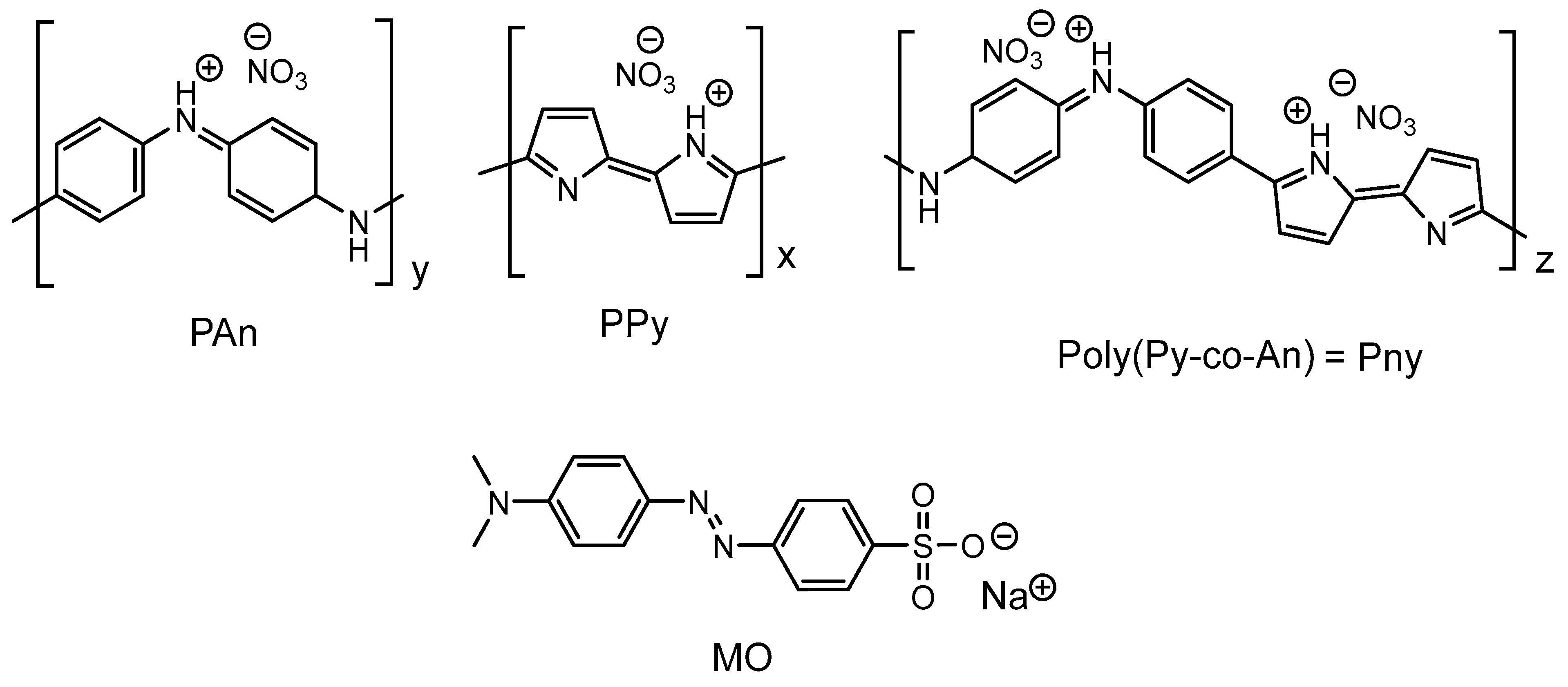
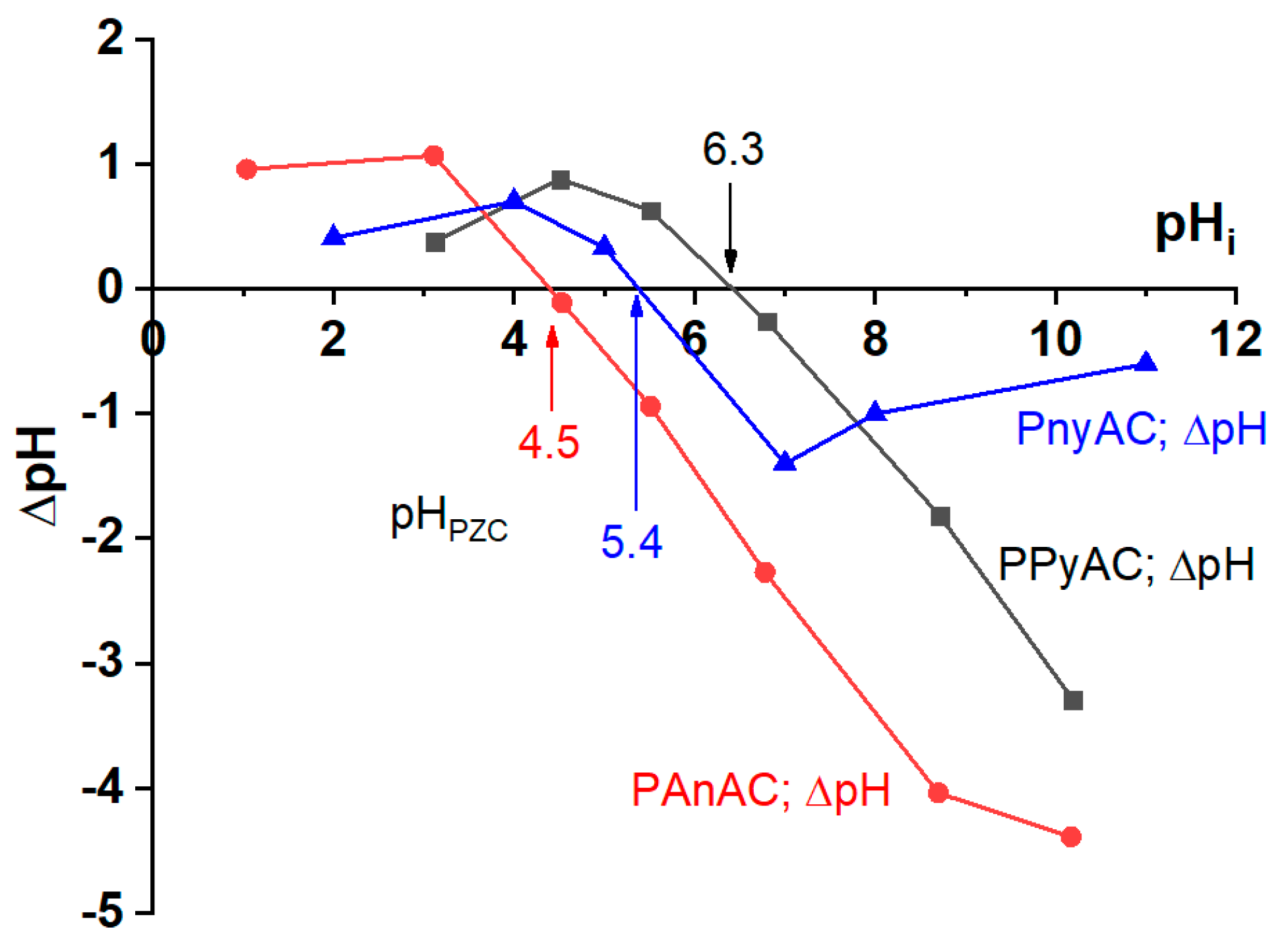
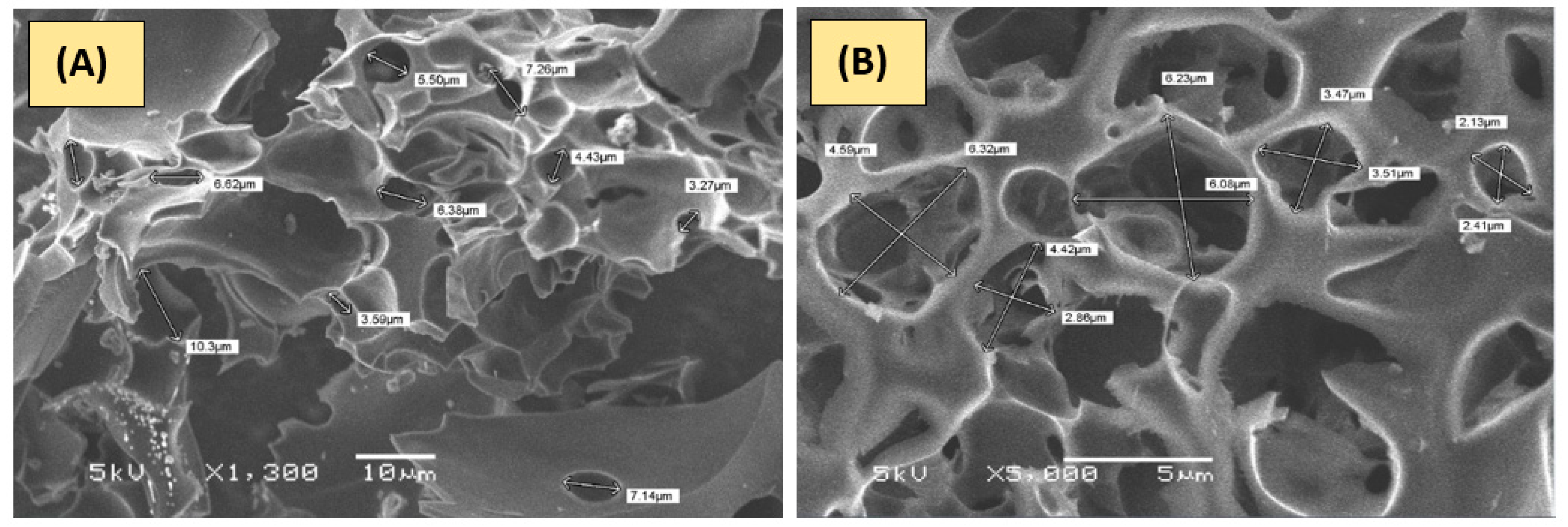
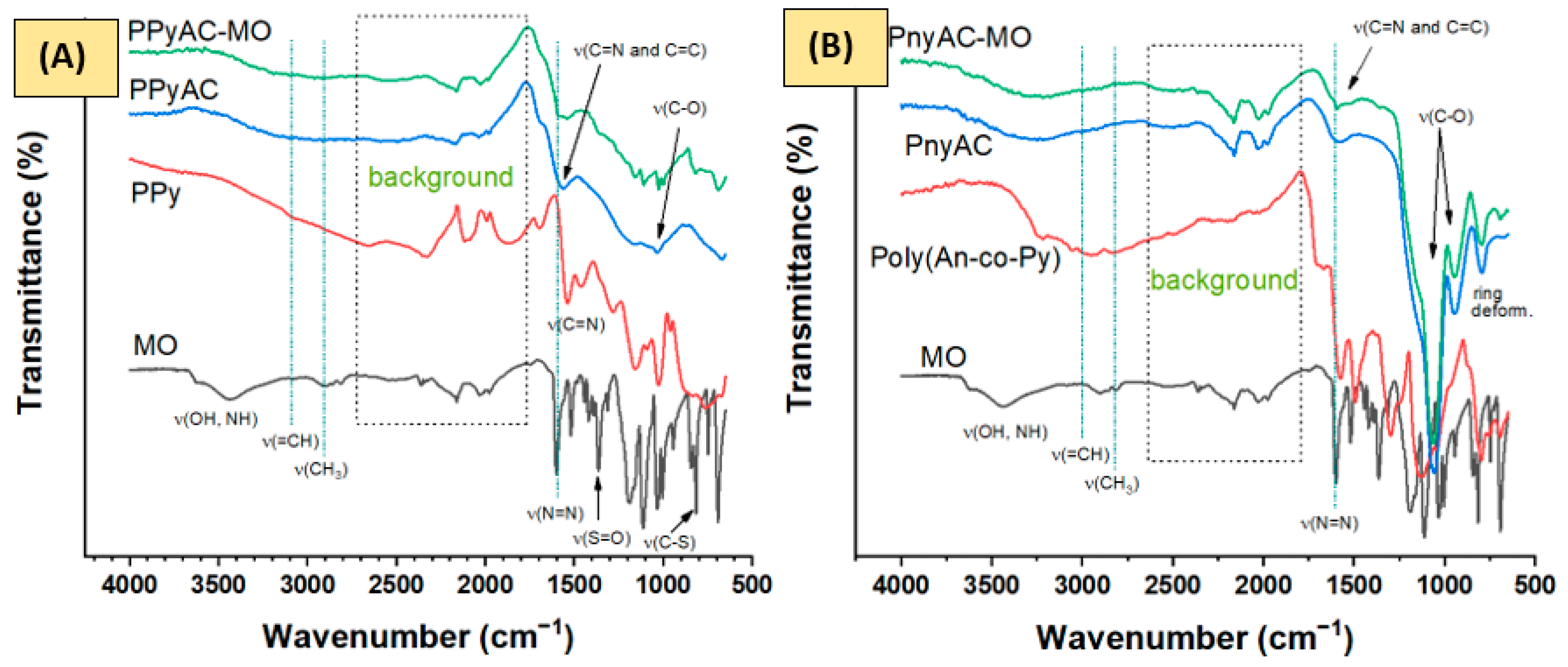
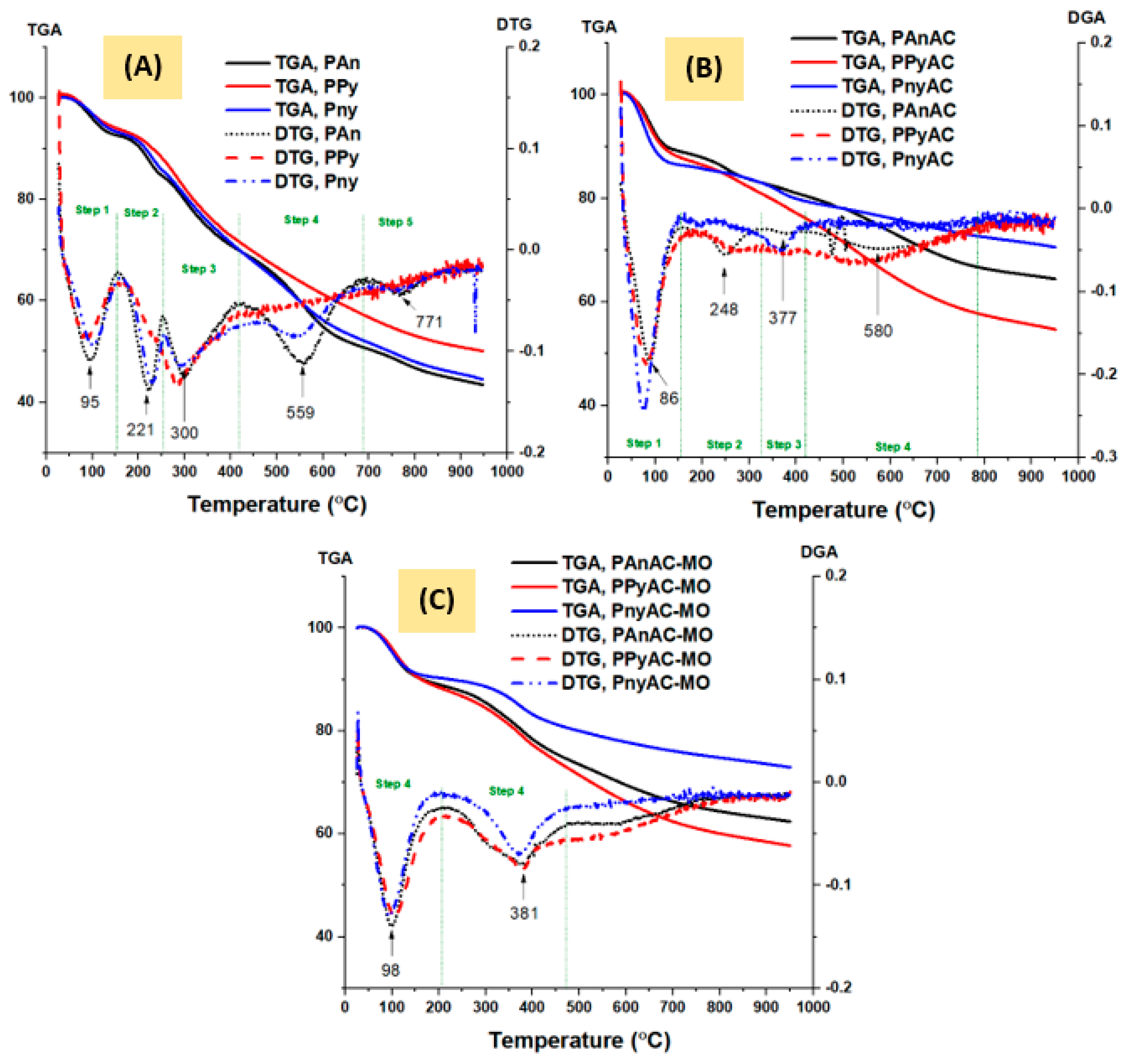
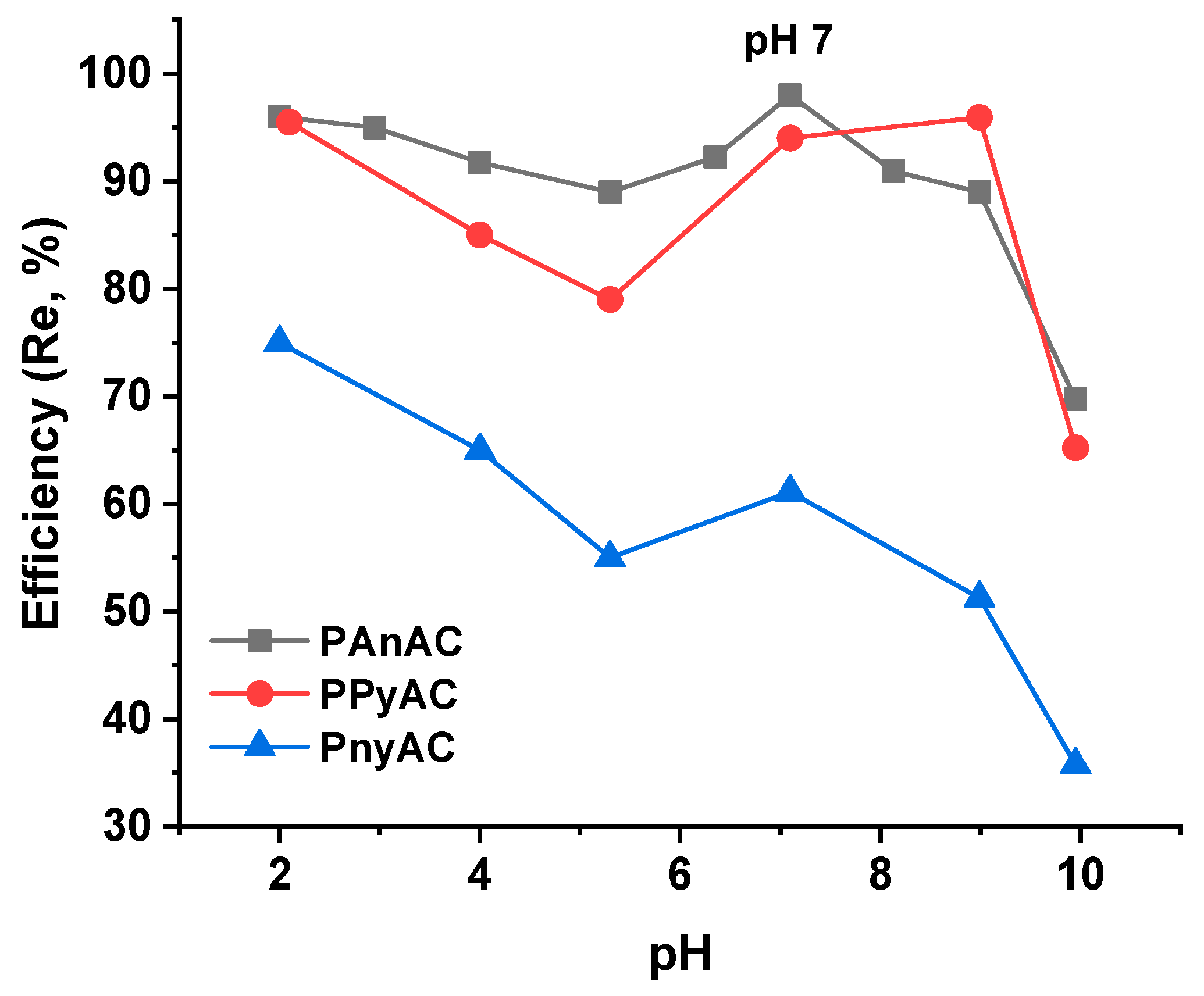



| Material | BET Surface Area (m2/g) | Average Pore Width (nm) | CO2 Capacity (mg/g) | Elemental Composition (wt%) | |||
|---|---|---|---|---|---|---|---|
| C | H | N | O ** | ||||
| PAnAC * | 1893 | 163.5 | 56.14 | 58.80 | 3.27 | 18.01 | 19.92 |
| PPyAC | 2157 | 158.9 | 48.41 | 73.46 | 0.57 | 6.95 | 19.02 |
| PnyAC | 1507 | 163.3 | 44.97 | 57.80 | 3.08 | 6.17 | 32.95 |
| Adsorbent | Conc. (mg/L) | qe, exp. (mg/g) | PFO | PSO | Elovich | Best Fit | ||||||
|---|---|---|---|---|---|---|---|---|---|---|---|---|
| 10−3k1 (min−1) | qe, calc. (mg/g) | R2 | 10−3k2 (min−1) | qe, calc. (mg/g) | R2 | α | β | R2 | ||||
| PAnAC [17] | 50 | 264.7 | 73.6 | 250.3 | 0.969 | 0.37 | 277.4 | 0.995 | 101.2 | 0.0214 | 0.985 | 2nd |
| 100 | 319.7 | 76.1 | 299.7 | 0.942 | 0.33 | 330.1 | 0.984 | 152.8 | 0.0178 | 0.992 | Elovich | |
| 200 | 405.0 | 84.4 | 368.9 | 0.957 | 0.30 | 405.9 | 0.992 | 223.1 | 0.0157 | 0.991 | 2nd | |
| PPyAC | 50 | 162.5 | 35.3 | 150.5 | 0.920 | 0.25 | 175.3 | 0.960 | 16.3 | 0.0272 | 0.986 | Elovich |
| 100 | 190.3 | 28.9 | 185.7 | 0.986 | 0.14 | 225.8 | 0.994 | 11.4 | 0.0183 | 0.992 | 2nd | |
| 200 | 203.6 | 12.9 | 188.4 | 0.933 | 0.85 | 205.5 | 0.963 | 245 | 0.0344 | 0.953 | 2nd | |
| PnyAC | 50 | 128.8 | 212.6 | 121.6 | 0.964 | 3.12 | 128.1 | 0.994 | 17,217 | 0.0954 | 0.991 | 2nd |
| 100 | 155.9 | 130.9 | 150.5 | 0.827 | 1.43 | 160.3 | 0.882 | 939.6 | 0.0556 | 0.869 | 2nd | |
| 200 | 182.0 | 79.4 | 181.2 | 0.946 | 0.57 | 199.1 | 0.922 | 92.8 | 0.0312 | 0.846 | 1st | |
| Adsorbent | Conc. (mg/L) | qe, exp. (mg/g) | Diffusion | |||||
|---|---|---|---|---|---|---|---|---|
| IPD | LFD | |||||||
| kid (mg/g·min0.5) | Cid (mg/g) | R2 | kfd (min−1) | Cfd (mg/g) | R2 | |||
| PAnAC | 50 | 264.7 | 19.3 | 68.2 | 0.833 | 0.033 | 0.32 | 0.970 |
| 100 | 319.7 | 22.7 | 86.4 | 0.840 | 0.038 | 0.22 | 0.948 | |
| 200 | 405.0 | 27.2 | 114.3 | 0.804 | 0.020 | 0.58 | 0.931 | |
| PPyAC | 50 | 162.5 | 12.5 | 19.4 | 0.959 | 0.038 | −0.42 | 0.728 |
| 100 | 190.3 | 16.5 | 9.8 | 0.970 | 0.027 | −0.03 | 0.956 | |
| 200 | 203.6 | 15.4 | 56.5 | 0.788 | 0.031 | 0.57 | 0.925 | |
| PnyAC | 50 | 128.8 | 7.2 | 60.9 | 0.558 | 0.028 | 1.12 | 0.911 |
| 100 | 155.9 | 9.9 | 63.6 | 0.661 | 0.033 | 1.10 | 0.868 | |
| 200 | 182.0 | 13.5 | 53.9 | 0.726 | 0.031 | 1.08 | 0.715 | |
| Adsorbent | Adsorbate | Capacity (qe; mg/g) | Condition: C0 (mg/L); Contact Time (t, min); Adsorbent Dosage (D, g/L); Temperature (T, °C); pH | Ref. |
|---|---|---|---|---|
| Merck; commercial activated carbon | Reactive violet 5 | 246 | C0 = 1000; t = 150; D = 2.5; T = 25; pH = 2; | [52] |
| Cocoa shell-based acidified activated carbon | 400 | |||
| Nitrogen-doped mesoporous carbons | Methyl orange | 135 | C0 = 200; t = 90; D = 1.0; T = 25; | [50] |
| Non-doped mesoporous carbons | 120 | |||
| LOBA Chemie; commercial activated carbon | 96 | C0 = 80; t = 250; D = 0.75; T = 25; pH = 2. | [51] | |
| Nitrogen-doped mesoporous carbon (NMC-3-800) | 160 | C0 = 300; t = 160; D = 1.0; T = 25; | [53] | |
| Nitrogen-doped nonporous carbon (N-NC-800) | 123 | C0 = 50; t = 360; D = 0.4; T = 25; pH = 6. | [54] | |
| Nitrogen-doped activated mesoporous carbon aerogel (NAMC) | 354 | C0 = 300; t = 180; D = 0.2; T = 25; | [55] | |
| Polyaniline | 111 | C0 = 120; t = 20; D = 1.0; T = 25; pH = 7. | [56] | |
| Polypyrrole | 147 | C0 = 150; t = 120; D = 1.0; T = 25; pH = 7. | [57] | |
| Polyaniline-based activated carbon (PAnAC) | 405 | C0 = 200; t = 60; D = 0.16; T = 24; pH = 6.4; | [17] | |
| Polypyrrole-based activated carbon (PPyAC) | 204 | This work | ||
| Poly(aniline-co-pyrrole)-based activated carbon (PnyAC) | 182 |
Disclaimer/Publisher’s Note: The statements, opinions and data contained in all publications are solely those of the individual author(s) and contributor(s) and not of MDPI and/or the editor(s). MDPI and/or the editor(s) disclaim responsibility for any injury to people or property resulting from any ideas, methods, instructions or products referred to in the content. |
© 2023 by the authors. Licensee MDPI, Basel, Switzerland. This article is an open access article distributed under the terms and conditions of the Creative Commons Attribution (CC BY) license (https://creativecommons.org/licenses/by/4.0/).
Share and Cite
Al-Odayni, A.-B.; Alsubaie, F.S.; Abdu, N.A.Y.; Al-Kahtani, H.M.; Saeed, W.S. Adsorption Kinetics of Methyl Orange from Model Polluted Water onto N-Doped Activated Carbons Prepared from N-Containing Polymers. Polymers 2023, 15, 1983. https://doi.org/10.3390/polym15091983
Al-Odayni A-B, Alsubaie FS, Abdu NAY, Al-Kahtani HM, Saeed WS. Adsorption Kinetics of Methyl Orange from Model Polluted Water onto N-Doped Activated Carbons Prepared from N-Containing Polymers. Polymers. 2023; 15(9):1983. https://doi.org/10.3390/polym15091983
Chicago/Turabian StyleAl-Odayni, Abdel-Basit, Faisal S. Alsubaie, Naaser A. Y. Abdu, Haifa Masfeer Al-Kahtani, and Waseem Sharaf Saeed. 2023. "Adsorption Kinetics of Methyl Orange from Model Polluted Water onto N-Doped Activated Carbons Prepared from N-Containing Polymers" Polymers 15, no. 9: 1983. https://doi.org/10.3390/polym15091983
APA StyleAl-Odayni, A.-B., Alsubaie, F. S., Abdu, N. A. Y., Al-Kahtani, H. M., & Saeed, W. S. (2023). Adsorption Kinetics of Methyl Orange from Model Polluted Water onto N-Doped Activated Carbons Prepared from N-Containing Polymers. Polymers, 15(9), 1983. https://doi.org/10.3390/polym15091983













